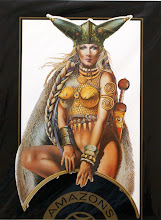Ángel Badia Camps was born in Puig-reig, in the Cataluña area of Spain, which borders southern France, in 1929. His father was exiled to France following the Spanish Civil War, only returning after nine years when Franco offered a conditional amnesty and allowed him to return and move with his family to Barcelona.
His love of drawing had begun early and Camps was encouraged by his parents but his knowledge of comics was limited to En Patufet and his education came with the discovery of American comics at the Sant Antonio market. Camps developed a fascination with American culture – with artists Milton Caniff and Alex Raymond and the films of John Ford and Howard Hawks, with American literature and the music of Glen Miller and jazz.
Camps attended the Escuela Superior de Bellas Artes. He began working professionally in Ameller, drawing fairy stories, and his work began appearing regularly in Florita, Aventuras de Capa Negra (17 issues written by Salvador Dulcet, 1953) and Pulgarcito (1954).
Although he drew comic strips, including the humorous stories of "Pilaropo al servicio de las damas" for La Risa (1956) and medieval historical tales Aventuras de Flecha Roja [Adventures of Red Arrow] (1956-57) and Flecha y Arturo (1956) for Ediciones Gráficas Ricart.
However, it was his work for romance comics such as "Marisol" (Lupita, 1950), Mariló, Sentimentale, Modelo, Dalia, Merche and Sissi that he established himself. He illustrated Bernadette (1956) for Editorial Bruguera. Through this romantic work, Camps developed a lengthy association with the British romantic comics' market, first appearing in Valentine in 1961. Over the next few years he contributed strips to Serenade, Roxy and True Life Library (1964). According to David Roach, "At first glance his drawing style was almost indistinguishable from [Jorge] Longaron's as he mixed a thrillingly loose and expressive line with an inventive and sophisticated sense of composition. His girls were the very epitome of 'the Spanish look' – heavy-lidded, thickly mascara'd eyes, big hair, big lips and lithe, languid bodies."
To give his work accuracy, Camps travelled to the UK and took over 300 reference photos of hospitals, buses, bridges, streets... everything had to be English which was not entirely a chore as his work coincided with the era of The Beatles, swinging London models and MG sports cars.
Camps is perhaps better known in the UK as a cover artist. Following his first appearance in 1960 on the Sexton Blake Library, he produced hundreds of covers for True Life Library, Star Love, Love Story Library, Oracle, Pop Pic Library, Charm, Young Lovers and other titles. The 1950s and 1960s were the heyday of magazine illustration before colour photography became the norm and Camps's paintings were widely reprinted throughout Europe and Scandinavia, often appearing
in women's magazines before being reused as covers elsewhere.
For his native Spain, Camps produced heavily illustrated translations of Heidi (1966) and Otra Vez Heidi (1966), based on the works of Juana Spyri, Los Hijos del Capitan Grant (1968) and Viaje al Centro de la Tierra (1969), both by Jules Verne, Aventuras de Tom Sawyer (1969) by Mark Twain and stories featuring Robin Hood (by Norman R, Stinnet) and Davy Crockett (by Elliot Dooley) for Editorial Bruguera.
By the late 1960s, he was working again almost exclusively for Spanish markets, Editorial Bruguera employing him on various lines of paperbacks, including Libro Amigo, La Conquista del espacio, and
Selección Terror. Camps also produced work for Molino, Toray and Ceres.
Although he was still earning a good living, and demand for cover artwork slowed in the 1980s as video became a more popular form of home entertainment than reading, Camps set up a school with fellow artist Rafael Cortiella, which ran for ten years. Camps subsequently concentrated on painting, although he had been exhibiting paintings since 1974.
Camps relates the story that he was painting whilst on holiday in Olot when the owner of a Barcelona gallery approached him and asked if he had ever exhibited his work. Camps said he was merely a Sunday painter but the gallery owner was persistent. "He asked if he could come to my studio and took almost everything I had." His work has, from 1986, featured in numerous solo exhibitions in Madrid, Barcelona, London, Brussels, Castellon and New York. His most regular exhibitor is the prestigious Sala Pares in Barcelona.
Examples of Angel Badia Camps' artwork can be found at the Illustration Art Gallery.
Wednesday, November 7, 2012
Subscribe to:
Post Comments (Atom)






















No comments:
Post a Comment